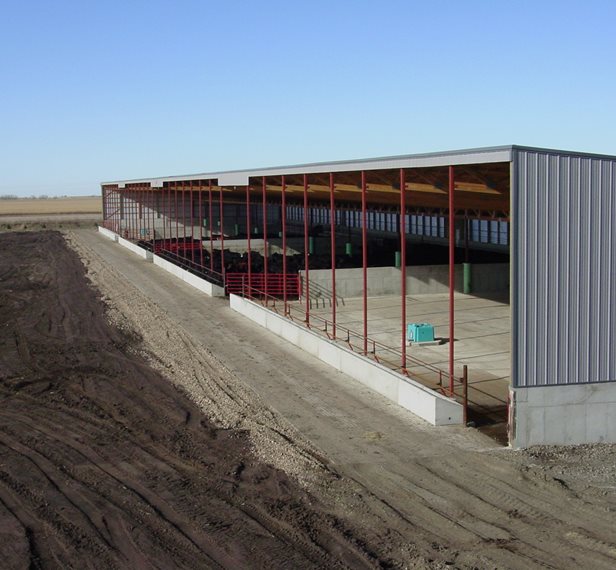Beef Barn: Benefits of a Monoslope Cattle Barn
While they may resemble long garages abandoned halfway through construction, monoslope beef barns have become a done deal for many beef producers. Increasingly, these barns are replacing conventional feedlots, and for good reason. Feeding cattle in “bedded confinement buildings” is showing impressive benefits for producers and cattle, alike.
Defining the Monoslope Barn
Before we jump into the benefits, let’s define monoslope barns. They have only one slope to their roof and feature a roof truss that is higher on the front side of the barn (typically facing south for winter sun exposure), sloping down toward the back (facing north for shade in the summer). Because two walls are left open for cross ventilation, they are sometimes called “cold barns.” The goal isn’t to keep the building warm (insulation is usually added only under the roofline to control condensation), but to keep cattle – and manure – dry and protected from harsh elements, especially moisture. Cattle have no continual access to an unroofed area. Many producers add a rear curtain along the north side, to be lowered during extreme weather.
.jpg)
Best Monoslope Cattle Candidates
While any cow can benefit from monoslope housing, Beth Duran with Iowa State University Extension and a topic expert, says there are four types of cattle that particularly excel in monoslope barns. “It’s those that don’t tolerate heat stress well: lightweight calves, market-ready animals, dairy steers, and black-hided cattle.”
Build for Durability
Lester Buildings has provided high quality, durable post-frame buildings for years. Al Miller, a rep with the company, has built several monoslope beef barns and only sees more on the horizon.
“The interest in monoslope barns has really picked up in the last four or five years. As the cost of feed and water increases in southern states, the Midwest is seeing a surge in beef production and these types of barns. Economically, they’re very cost effective.” Lester distinguishes its buildings with a flexible design, unique add-ons, and a long history in livestock structures. The company’s monoslope beef barns feature a long span central header to minimize interior columns, and a clean truss design that discourages birds and maximizes overhead space for maneuvering equipment.

The Many Benefits of Monoslope
- Profitability – Monoslope barns require 44 to 50 square feet per head compared to 350 square feet per head in open lots, making the land cost per head much cheaper. Managing labor and manure is simplified, too.
- Performance – Research is showing that cattle housed in monoslope barns have a 15 to 20 percent increase in average daily weight gain over open lots. This is especially true during summer months, when heat can make appetites wane. Cattle also don’t waste energy trudging through muddy pens and snow, and they have easy access to concrete feed bunks.
- Cattle Comfort – Monoslope barns provide cover for cattle during weather extremes (shelter barns are 10 to 15 degrees cooler in the summer) and offer ample summer and winter ventilation. Keeping cattle under shelter decreases animal stress and improves their overall health and comfort.
- Manure Management – More producers are building monoslope barns with manure bays within the structure. Containing the manure and keeping it protected from rain and snowmelt offers many benefits. Foremost, it reduces feedlot run-off, odor and environmental concerns. Keeping manure dry also increases its nutrient levels and value, since it’s not diluted.
Are there any downsides to a monoslope beef barn? According to Miller, no. “Sure, there’s an investment up front, but you’ll see a return on that investment faster, especially with fertilizer savings. Even lending banks see it as a win-win.”
View Photos!
Visit lesterbuildings.com to see its library of monoslope beef barns, including those in your area.
